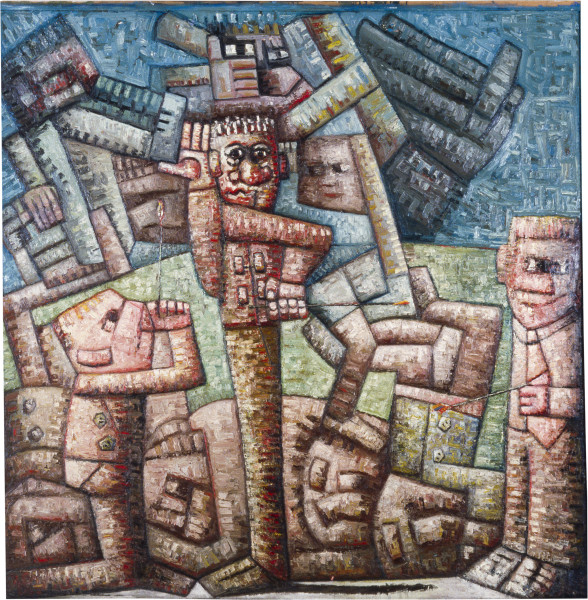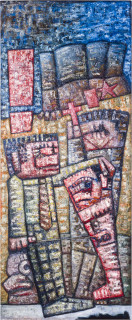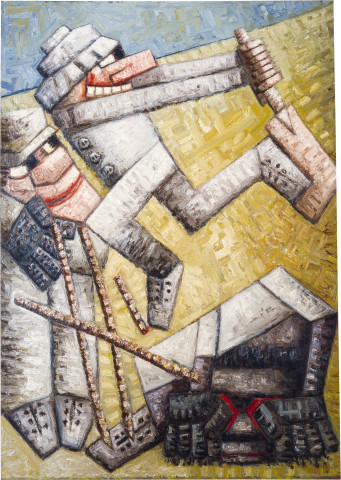Social Symbol Nothing Private and Full Bureaucracy Suieet
Exhibition Dates: 6 December – 22 December 1984
Letter to Artmaster
11th November '84
Dear Sir,
While counting up the last 25 years of exhibiting, I've been reminded of some of the opposed things that you've said about my painting and drawing and am led to believe, by your conflicting statements, that you've never come to a satisfying conclusion. So I thought I should return your kindness by helping you with your problem, perhaps by going back to the beginning in London.
The first and last painting that we passed during the retrospective of Daumier's works at the Tate Gallery in 1961 was a Crucifixion.
I'd just arrived in Europe and although the Daumier show overwhelmed me more than any I had experienced, it was your reaction to that Crucifixion that remains with me. I simply couldn't share your enthusiasm.
For the first time I watched as a painting had its identity changed to accommodate your emerging social-artistic formula, one completely opposite to the origins of Daumier and his work.
Your excitement then was for the spirit of paint and for the vision that descends upon blind and dying artists. Through this painting, and only this one, the devout humanist could earn redemption from his humanity while at the same time herald the mystery of modernism. So spake your new Academy.
In Daumier's uncharacteristic subject matter you uncovered an ambiguous emergence. For you the painting's strength was located in its complete lack of definition so that its mystique rested in the vigour of discarded fuss. Such a work complemented Figurative Abstraction - de Kooning maybe? Historical intention seemed not to matter to you. Everything was in the look.
At 21, I was confused. Daumier had been a hero of materialist intentions and even if, near the end, as seems obvious, he had some need for a religious experience, it was not one that could be related to his art. He had for too long worked to master the art of caricature, a fact which even you could not force the rest of his exhibition to deny. No matter what this crucifixion's relevance to personal salvation, I believe that Daumier, the artist, had died before this picture.
With nothing left of the great draughtsmanship that had expressed a humour unparallelled in modern masters, you felt free to turn Daumier from the great social witness into a depictor of minimalist mysteries.
The first post-war comprehensive exhibition of Australian painting was also on in London which was full of our mutual friends from back home. My conflicts over the Daumier were not so much with other painters but with your emerging type of art administrator: the director and curator as entrepreneurs, plus the coming race of caretakers.
It was the start of a new art world government that could detach Daumier's Crucifixion from any moral expectation in the artist's life. Later you would not only reinterpret an artist's intentions, but become that artist.
In 1962, when I moved to Turin, I attempted several Antipodean pictures influenced by those I had seen just before leaving Australia. I believe I failed in the development of those paintings because I could no longer sustain the essentially Romantic notion of art. I was not aware of it at the time but on reflection, I now realise that your reinterpretation of Daumier's Crucifixion symbolises the effect that your Academy has had on my direction every since.
My assumption during the artistic cold war was that, even if your international hard edge abstraction, with its puritanical respect for the integrity of the picture plane, was not the ultimate cleanser of illusion and expressionist indulgence, at least it would clear the air for a fresher approach. I hoped that when our individual licences were granted, we all would be stronger in the renewed environment of electicism. For the moment, international abstraction would have to force its inevitable course. That was my optimistic estimate of your honest intentions. I was only 21 at the time.
I agreed with your argument that traced Modernism back to Manet's Bar at the Follies Bergere and I accepted the flatness of the picture. But if the Greenbergians could make assumptions about the cleansing path of the picture plane, I thought I would do some divination of my own.
What justification did you have for accepting the integrity of the picture plane while abandoning moral control over the imagination?
Why did the purity of Manet's vision coincide with the culmination of the careers of those great moral witnesses, Courbet and Daumier? There were grounds for believing that if Courbet's life had not been frustrated by a bravery of moral purpose, he too might have played a decisive role in the development of Impressionism. After all he was not a man conditioned by reactionary biases and there were times when he had been possessed by a clarity of vision.
I also questioned why you thought that moral passivity, apart from Leger, had to be the only path for Modernism? Did a devout socialist such as Pissarro have to possess such a limited purity of vision that it divourced itself entirely from the Jewish cause of his political convictions? We can accept his Impressionism only as part of an ethical ideal, one which had to be overwhelmingly optimistic. Otherwise, I could see only an artist of split intentions such as reached a terrible finality in the more intelligent awareness of Van Gogh whose conflict between art and social purpose you helped to glamorise as a divine madness.
I wasn't seeking any partisanly political subject matter. Rather I accepted that subjects worked through the medium of paint to breed a moral imperative as important as the integrity of any picture plane.
Such were the ideas that prompted me to begin on the eighty drawings that eventually made up The History of the World which started - as did my later History of Australia - as an island, with a tree in the centre, flora on one side and rock on the other. The floral side was the area of art and aesthetics. Under the tree there was religious security. On the rock stood the builders of material and martial power. Each drawing depicted how the inhabitants of each part joined and opposed each other along their historical journey.
My point in those drawings, as in this letter, has been to show you the meaninglessness of each area when it is cut off from the other realms of life. Just recently you have swung around towards my point of view with your perplexed delight in Guston and your invention of transavantgardeing. Not that it matters. When the next breezes blow you will still be their weather vane. Hence, I suspect our paths will cross again. Meanwhile, what do you have to say about your crucifixion of Daumier?
Yours sincerely,
Looby

from the series Life as prohibited mural
oil on canvas
285 x 285 cm



























